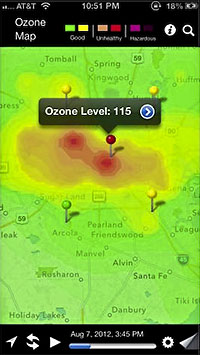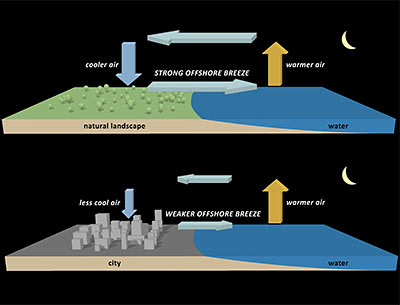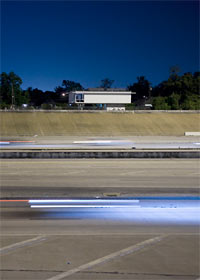NOW ON YOUR MOBILE DEVICE: WHY YOU CAN’T BREATHE  A team comprising researchers at UH, Air Alliance Houston, and the American Lung Association have launched OzoneMap, an app that “monitors chemical weather,” reports John Metcalfe of The Atlantic blog Cities. And whether the app helps explain your coughing fit or alerts you to the chance of a really pretty toxic sunset, the best part is that it’s only available in Houston! And why Houston, of all places? Besides the industrial flares, that is? Here’s Metcalfe: “The Houston/Baytown/Huntsville region comes in eighth place for most ozone-polluted cities in America, as ranked by the American Lung Association. Persistently sunny weather, a battalion of petrochemical facilities and scads of fuming cars on the road make Houston a nightmare for anyone who’s chemically sensitive. For these folks, walking outside is like playing a lower-stakes version of Russian roulette, with 30 to 40 days of the year fogged with hazardous levels of ozone.” [Cities; previously on Swamplot] Map: Cities
A team comprising researchers at UH, Air Alliance Houston, and the American Lung Association have launched OzoneMap, an app that “monitors chemical weather,” reports John Metcalfe of The Atlantic blog Cities. And whether the app helps explain your coughing fit or alerts you to the chance of a really pretty toxic sunset, the best part is that it’s only available in Houston! And why Houston, of all places? Besides the industrial flares, that is? Here’s Metcalfe: “The Houston/Baytown/Huntsville region comes in eighth place for most ozone-polluted cities in America, as ranked by the American Lung Association. Persistently sunny weather, a battalion of petrochemical facilities and scads of fuming cars on the road make Houston a nightmare for anyone who’s chemically sensitive. For these folks, walking outside is like playing a lower-stakes version of Russian roulette, with 30 to 40 days of the year fogged with hazardous levels of ozone.” [Cities; previously on Swamplot] Map: Cities
Air Quality
COMMENT OF THE DAY: OH, AND WATCH OUT FOR THOSE AREAS NEAR THE SHIP CHANNEL TOO “If you are looking inside the loop at places like Eastwood or just outside the loop at places like Oak Ridge and Westbury, be careful that your house is at least 1000 feet from any highways. Living within 1000 feet of a major highway can expose your children to serious air quality issues in addition to what we already have to endure in Houston. Also, make sure that you get the house tested for lead paint and be ready to have some cash on hand to do some work to remediate any lead paint on the interior and any lead paint that is coming off on the exterior. I always thought that I was being overly cautious when I had my house remediated before moving in. But one day I had my then 4 month old baby on the changing table and watched as he scratched the paint on the wall with his finger and then put his finger in his mouth . . .” [Old School, commenting on Crazy for the Inner Loop]

HISD has now contracted with an industrial hygienist to evaluate the drainage systems, mechanical rooms, and plumbing and electrical systems at Barnett Stadium in an attempt to determine what might have caused 22 band or dance-team members from Stephen F. Austin High School to become mysteriously ill during a football game there Friday night. Several students displayed what appeared to be symptoms of carbon monoxide poisoning. Epidemiologists have been interviewing students and school officials “to get information on the whereabouts of the band members within the stadium and collect other health related-factors that could have played a role in the event,” the school district announced. The HISD Athletics Department is expected to announce tomorrow morning whether 2 UIL playoff games scheduled for this week at the 6800 Fairway Dr. location will be moved to a different field.
- Questions still remain about sick students at football game [abc13]
- HISD hiring own investigator in stadium illness case; facility may stay closed, games switched [West U Examiner]
Photo: Paragon Sports
COMMENT OF THE DAY: WESTERN AIR “. . . in cities old enough to predate water systems it was common for the favored side to grow upstream. Even after city sanitation, flood control, and car ownership that makes it possible to live ‘way up a hill without having to have the leisure to live so far from things – and even where that legacy doesn’t hold over in property investment – air quality is generally better higher up, nevermind views: so that in North America, where our water often flows to the east and south, even newer cities often favor west and north. Especially north. Nashville, Monterrey, East Bay, Memphis, and others where the east or south is higher ground, or cities where race riots took place after city sanitation came around, prove the rule by suggesting how much it takes to buck it and confirming why. Think about it and see why else you can come up with!” [Austin, commenting on Comment of the Day: The Common Divide]
PICKING UP CASH FOR THE CHEMICAL SPEW How did Harris County government swing half a million dollars in cash from Shell Chemical? The company is turning over that amount as part of a settlement covering 5 unreported chemical releases between April 2008 and March 2010 at the company’s Deer Park plant on Hwy. 225 just east of Beltway 8. According to Harris County’s lawyer on the case, Shell Chemical also made an “important concession,” which will likely result in more advance warning of similar future windfalls headed our way: Shell says it’ll now alert the county’s local pollution control office, and not just state officials, of “pollution events.†[Pasadena Citizen]

A new study from the National Center for Atmospheric Research documents how Houston’s vast expanse of paved surfaces allows the city to hold onto locally developed air pollution for longer periods of time, and prevents breezes that would otherwise naturally develop from sending all that nasty smog and stuff to outlying areas. Concrete and asphalt paving helps by soaking up heat during the daytime. This keeps land areas relatively warm overnight, which means there’s a lower contrast between land and sea temperatures during the summer. The result? Much less of those smog-stealing nighttime summer breezes. During the daytime, Houston buildings help to block local winds and keep things more still in the afternoon. Just another way standard development practices allow Houston to be a responsible steward of its own locally produced airborne products.
Raw helicopter footage from abc13 of the fire currently raging at the Enterprise Products natural gas fractionation facility at 135 Sun Oil Rd., just east of Hwy. 146 in Mont Belvieu. By 3:55 in, the view gets better, and you can hear the commentator noting that the fire was visible from above Hobby Airport, just 30 miles away.
- Explosion, fire burning at Mont Belvieu facility [abc13]
- Plant burns in Mont Belvieu [Houston Chronicle]
Video: abc13
RAINY DAYS AND SUNDAYS ALWAYS GET ME DOWN “So it stinks like something awful again where I am today (the Heights). I look at the calendar and realize it’s been 2 prime dump days in a row, a wet Sunday followed by a national holiday. An old friend of mine who grew up on the east side used to say that a Sunday when it rained was the perfect day for all the refineries to release their nastiest emissions, because the rain masked it and for some reason there wasn’t any enforcement on the weekend. I’m wondering where else in the city it smells like what I’m smelling, and is there any truth to the rainy-day-dump theory? That’s some strong anecdotal evidence in my nostrils.” [Swamplot inbox]
COMMENT OF THE DAY: WHEN ALL WE SEE IS THE VIEW TO A KILL  “I like the ‘idea’ of this house, and the view of downtown is very nice. However, what about the well-documented health [effects] of living near (or extremely near, in this case) freeways? Are the increased risk of cancer, heart disease, asthma, premature births and so on a worthwhile trade-off for living in a conceptual design statement? Maybe they have some kind of cool air-pollution filtration system….” [Mies, commenting on Self Directed: A Modern House Angled for 288’s Best Freeway Views]
“I like the ‘idea’ of this house, and the view of downtown is very nice. However, what about the well-documented health [effects] of living near (or extremely near, in this case) freeways? Are the increased risk of cancer, heart disease, asthma, premature births and so on a worthwhile trade-off for living in a conceptual design statement? Maybe they have some kind of cool air-pollution filtration system….” [Mies, commenting on Self Directed: A Modern House Angled for 288’s Best Freeway Views]

That proposed underground pipeline linking Houston to the luscious bounty of Canadian strip-mined tar sands will sneak into Houston from the east, and won’t even make it inside Beltway 8, according to this map released by the State Department. The line is scheduled to carry up to 500,000 barrels a day of crude oil to Texas alone — probably more than 8 times as much oil as the successors to the Deepwater Horizon are currently delivering directly to the Gulf of Mexico.
TransCanada plans to stitch the pipeline over the Ogallala Aquifer, which supplies water to part of Texas and much of the Midwest.
The pipeline also would cross more than 30 rivers and streams in Texas and could run underneath the Big Thicket National Preserve, said environmentalists and landowners.
Texas and Oklahoma portions of the 2,000-mile-long Keystone XL pipeline are still under review; this Friday is the deadline for public comment on the draft environmental impact statement released in April.
[TransCanada VP Robert Jones] defended the project, saying pipelines are the safest way to transport oil. The company will use pipe that has been employed safely in Canada for years and bury it 4 feet deep, he said.
Jones also downplayed concerns about Houston’s air quality, saying the Canadian crude is replacing oil from other sources and has not led to changes in the refineries’ pollution permits.
But [Matthew] Tejada, of Air Alliance Houston, found fault with TransCanada’s position. He said the tar-sands crude when refined will emit higher levels of sulfur dioxide, nitrogen oxides and particulate matter into the air than conventional oil.
- Proposed oil pipeline to Texas raises worries [Houston Chronicle]
- Keystone Pipeline Project [TransCanada]
COMMENT OF THE DAY: CLEAR LAKE CITY CLEANS UP NICELY “Is there a discount [for homes near chemical plants]? Hell yes! And it’s for lots of reasons: 1) real or perceived pollution, 2) real or perceived high crime, 3) low elevations, 4) higher property insurance rates, 5) fewer nearby white collar jobs, and 6) living there indicates to snobs that you’ve got a low social status. Most of the discount is unwarranted, but it’s a self-fulfilling prophecy. Look at Clear Lake City; parts of it are only about 1.5 miles from the nearest chemical plants. It was developed upon depleted oil fields and is adjacent to still-active fields. (It was developed by a subsidiary of Exxon!) It’s adjacent to an airport. It has a low elevation. But all that stuff is out of sight, out of mind, and so there’s no stigma.” [TheNiche, commenting on House Shopping in the Chemical Discount Zones: Finding Houston’s Less-Toxic Neighborhoods]
HOUSE SHOPPING IN THE CHEMICAL DISCOUNT ZONES: FINDING HOUSTON’S LESS-TOXIC NEIGHBORHOODS “A commenter on your blog who says he works at a chemical plant recently wrote that a neighborhood 1 mile from a chemical plant ‘is never going to be an “OK” neighborhood.’ Is there a single citywide map that shows where all these plants are, so I can find a place to live accordingly? And how far do I have to be from a chemical plant to be ‘OK’? 5 miles? 20? I presume there’s no absolute answer. But there’s got to be a de facto ‘discount’ on homes in neighborhoods that are within certain radiuses of the toxic stuff, right? If so, how far do the discount zones extend? Could someone draw that map for me?” [Swamplot inbox]
COMMENT OF THE DAY: WE’RE FROM THE TEXAS MEDICAL CENTER AND WE’RE HERE TO HELP “Given all the refineries, industrial plants, chemical plants, railroads, stagnant swamps and cesspools, traffic pollution, and the like that plague this hellhole of a town, it is a freaking wonder that Houston doesn’t lead the nation in cancer cases.” [Random Poster, commenting on Today’s Odor in Baytown Is Brought to You by ExxonMobil]
TODAY’S ODOR IN BAYTOWN IS BROUGHT TO YOU BY EXXONMOBIL The most recent smell, of rotten eggs, has been claimed by the folks at ExxonMobil’s Baytown Refinery. Fortunately, local news outlet Reuters UK is on the story, filing one of the few reports on the incident, which we quote here in full: “Exxon Mobil said Wednesday there was an operational issue at its 562,500 barrel-per-day refinery in Baytown, Texas but gave no details as to the scope and units involved. ‘I can tell you there was no impact to production,’ said Kevin Allexon, a spokesman for the company.” [Reuters UK]
COMMENT OF THE DAY: AND ON ANY RAINY SUNDAY “Well, Christmas Day and New Year’s Day are coming up, an opportunity for the Annual Unscientific Anecdotal Take A Whiff Holiday Bingo. First thing in the morning on these two holidays, open your windows or step onto your porch or balcony, face the southeast, and take a big sniff of the air. 99% guarantee you’ll get a strong odor of Eau de Ship Channel. After 20 or so years of this I’m convinced that the plants take advantage of the holiday (no one manning the phones at TCEQ) to flush the toilets, as it were, and let the emissions fly.” [Miz Brooke Smith, commenting on How the TCEQ Helps Houston Air Stay So Fresh and Clean]

